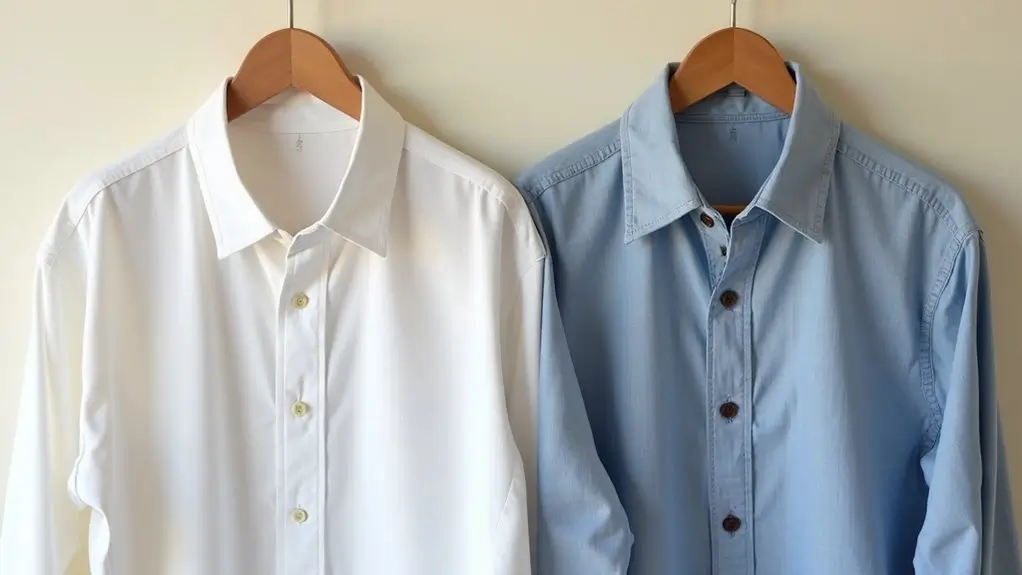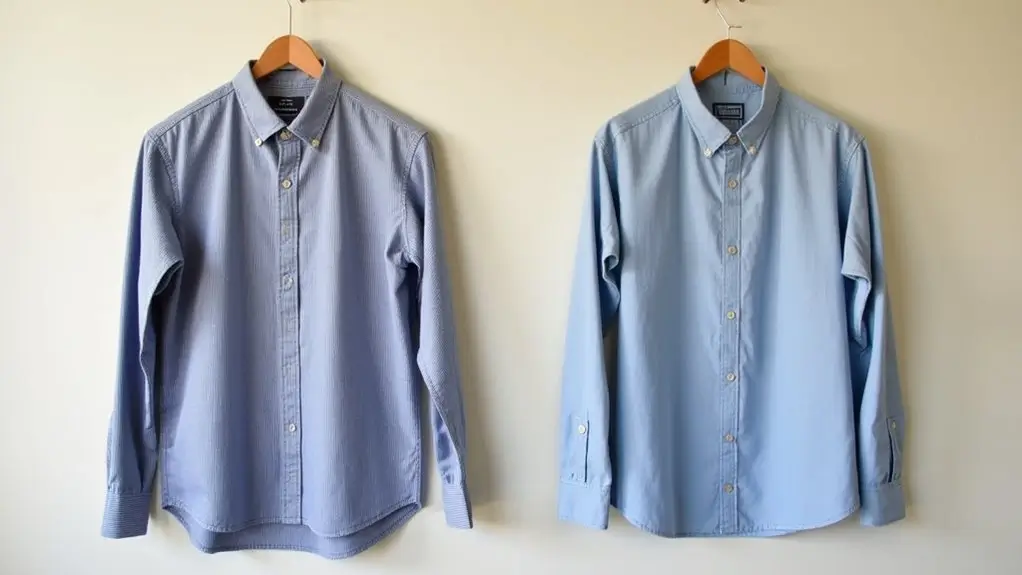When you're comparing shirt fabrics, you'll find that Oxford and chambray represent two distinct weaving traditions. While both textiles have cotton foundations, their construction methods create remarkably different characteristics. Oxford's signature basket weave pairs thin and thick yarns for a structured feel, while chambray's plain weave combines white and colored yarns for a softer finish. Understanding these fundamental differences will help you make informed choices about which fabric best suits your needs.
Key Takeaways
- Oxford fabric features a basket weave with thick warp and thin weft yarns, while chambray uses colored warp with white weft in 1:1 weave.
- Oxford shirts are heavier and more durable, suitable for professional settings, while chambray offers lighter, casual comfort for everyday wear.
- Chambray performs better in warm weather due to its lightweight nature, whereas Oxford cloth provides more warmth and layering potential.
- Oxford shirts require structured care with cold washing, while chambray needs gentler handling and air drying to maintain its characteristics.
- Oxford fabric becomes softer over time while maintaining durability, whereas chambray starts soft but may wear differently with extended use.
Introduction to Oxford and Chambray Shirts

Oxford cloth features a distinctive basket weave construction where two lengthwise yarns interlace with a single crosswise yarn, creating its signature textured appearance and durability you'll recognize in traditional button-down shirts.
Chambray's weave structure consists of a colored warp yarn, typically indigo, and white weft yarns in a 1:1 plain weave ratio, producing a lighter weight fabric that's often mistaken for denim.
While both fabrics commonly use cotton fibers, you'll find Oxford's heavier basket weave creates a more structured drape, whereas Chambray's simple plain weave results in a softer, more fluid characteristic.
What is Oxford Cloth?
A distinguished basket weave construction defines Oxford cloth, featuring thicker warp yarns crossed with thinner weft yarns. This variation on a plain weave creates a unique texture that's both refined and casual.
While traditionally made from cotton, you'll find Oxford cloth also incorporates synthetic blends for enhanced performance.
The fabric's distinctive weave structure makes it exceptionally durable, with a slightly rough surface that softens over time.
You can identify genuine Oxford cloth by its characteristic pebbled appearance and subtle luster. The weave's larger yarns create small geometric patterns and tiny holes at the intersections, allowing for better breathability.
What is Chambray Fabric?
Chambray's distinctive construction features a colored warp yarn interwoven with white weft yarns in a plain weave pattern, creating a fabric that's often mistaken for lightweight denim.
You'll find chambray sets itself apart through its unique weave structure, where dyed warp threads intersect with undyed weft threads. This construction creates a characteristic sheen and subtle color variation on the fabric's surface.
- The plain weave makes chambray softer and more breathable than similar fabrics.
- Warp yarns are typically dyed indigo, though other colors are common.
- Single-ply construction results in a lightweight, smooth hand feel.
Overview of Differences
While chambray showcases a distinct plain weave construction, understanding how it differs from Oxford cloth opens up important considerations for shirt selection.
You'll find that Oxford fabric features a basket weave pattern with heavier weight yarns, creating a more textured appearance and enhanced durability.
In contrast, chambray's lightweight plain weave uses a colored warp and white weft, producing a smoother texture and softer comfort profile.
Both materials excel in casual settings, though Oxford shirts typically offer more structure and formal versatility.
The fabric construction directly impacts their performance - Oxford's looser basket weave provides better breathability, while chambray's tighter weave delivers a more refined drape.
Style Comparisons

Oxford shirts maintain their popularity through classic buttondown collars and basket-weave constructions, while you'll find chambray's plain-weave aesthetic trending in both workwear and casual fashion segments.
The versatility of both fabrics extends across formal and casual boundaries, with Oxford cloth dominating collegiate and business-casual environments while chambray excels in casual and Americana-inspired styling.
Popular Styles of Oxford Shirts
A thorough look at button-down oxford shirts reveals distinct style variations in today's market. The classic oxford weave, characterized by its basket-weave pattern, offers timeless versatility in both formal and casual settings.
- Traditional Oxford: Features a standard 40s x 40s thread count, creating a stylish textured appearance with a formal basket weave using contrasting warp and weft threads.
- Pinpoint Oxford: Utilizes finer 80s x 80s yarn count, delivering a smoother, more refined finish ideal for business attire.
- Royal Oxford: Incorporates complex 120s x 120s thread patterns, producing a lustrous surface with elevated formality suitable for upscale occasions.
Trends in Chambray Fashion
Modern chambray shirting has evolved considerably from its workwear origins, distinguished by its unique plain weave construction using colored warp and white weft yarns.
You'll find today's chambray fabric trends emphasizing lighter weights and softer finishes, making them comfortable for everyday wear.
Fashion designers are incorporating chambray into fresh silhouettes beyond traditional workwear styles.
The fabric's breathable nature makes it ideal for summer garments, while its versatile cross-dyed appearance creates subtle depth.
You'll see chambray trending in relaxed cuts, featuring innovative fabric blends that enhance drape and performance.
This evolution has positioned chambray as a sophisticated alternative to denim in contemporary casual style.
Care and Maintenance of Fabrics

Proper care of your oxford cloth requires cold-water washing and gentle tumble drying to maintain the characteristic basket weave structure between cotton warp and weft yarns.
You'll need to handle chambray's unique plain weave more delicately, washing in cool water and avoiding high heat exposure that can compromise the fabric's signature color-and-white yarn composition.
For both fabrics, removing shirts promptly from the dryer and hanging them on wooden or padded hangers will preserve the integrity of the fibers and prevent unwanted creasing in the weave patterns.
Washing and Drying Oxford Shirts
Since Oxford cloth's distinctive basket weave requires special attention, maintaining your Oxford shirts demands specific laundering techniques. The difference in wash care comes from the fabric's solid construction and unique fiber interplay.
- Use cold water and a gentle cycle to relax the weave structure while preserving the fabric's integrity.
- Choose a suitable mild detergent specifically formulated for cotton-blend clothing to maintain fiber strength.
- Smooth wrinkles while damp and hang dry, or tumble dry on low heat to prevent damage to the basket weave pattern.
These steps will help preserve your Oxford shirt's characteristic texture and durability through multiple launderings.
Maintaining Chambray Quality
While chambray's characteristic indigo warp and white weft create its beloved denim-like appearance, this lightweight cotton fabric requires specific maintenance to preserve its unique cross-weave structure.
To maintain chambray's durability and breathability, you'll need to wash it in cold water on a gentle cycle.
Compare this to denim's thickness and strength - chambray's more delicate weave means you should avoid harsh detergents.
Feature-preserving tips include turning the garment inside out before washing and avoiding fabric softeners, which can weaken the tightly woven fibers.
Air-dry your chambray shirts whenever possible to prevent shrinkage and maintain the fabric's characteristic drape and texture.
Choosing the Right Shirt

Oxford's basket weave construction makes it your go-to choice for business-casual environments, while Chambray's plain weave with colored weft and white warp creates a more relaxed aesthetic for casual settings.
You'll want to take into account fiber composition alongside weave structure, as cotton Oxford cloth offers superior breathability compared to synthetic blends, and pure cotton Chambray develops a distinctive patina over time.
When selecting between these two fabrics, prioritize Oxford for its structural integrity in professional contexts and Chambray for its dimensional character in leisure wear.
When to Wear Oxford vs Chambray
Fashion-conscious dressers need to understand the key distinctions between Oxford and chambray shirts to maximize their versatility. The appropriate choice depends primarily on weather conditions and your intended style.
- Oxford shirts are your go-to option for cooler weather, offering a more structured appearance that's perfect for dress occasions or professional settings.
- Chambray excels in warm weather, providing breathability while maintaining a stylish look that works for everyday wear.
- Both fabrics adapt well between seasons, but Oxford's heavier weave makes it more suitable for layering during cooler weather.
Choose Oxford for formal versatility and chambray for casual refinement.
Final Thoughts on Fabric Selection
Selecting the ideal shirt fabric requires an extensive understanding of fiber properties, weave structures, and wear characteristics. When you choose between Oxford and Chambray, consider their distinct properties.
Oxford's unique basket weave typically offers more durability and structure, making it suitable for formal settings. Chambray's plain weave creates a softer, more casual appearance with its color-and-white yarn combination.
Consider your lifestyle needs: Oxford's rugged construction works well for frequent wear and washing, while Chambray's lighter weight suits warmer climates.
Each fabric's specific weave pattern and fiber composition delivers different performance benefits, affecting your shirt's longevity and comfort.
Frequently Asked Questions
Can Oxford or Chambray Shirts Be Worn in Formal Black-Tie Events?
You shouldn't wear oxford or chambray shirts for black-tie events. Their casual basket weave and denim-like constructions don't meet formal dress codes. Instead, opt for a formal cotton poplin or twill dress shirt.
Do Oxford and Chambray Shirts Shrink Differently When Washed?
You'll find Oxford's basket weave construction tends to shrink more uniformly, while Chambray's plain weave typically experiences less overall shrinkage due to its tighter fiber structure and lighter-weight cotton composition.
Which Fabric Is More Sustainable and Environmentally Friendly?
You'll find that chambray's simple weave requires less energy to produce than oxford's basket weave. When made from organic cotton, both fabrics can be sustainable, but chambray's simpler construction gives it an edge.
Are Oxford and Chambray Shirts Suitable for Hot Tropical Climates?
You'll find chambray's plain weave and lighter weight more suitable for tropical climates. Oxford's basket weave construction is heavier and less breathable, though you can opt for lightweight Oxford variants in tropical settings.
Can These Fabrics Be Effectively Used in Women's Business Attire?
You'll find both fabrics excel in women's business attire. Oxford's basket weave creates structured silhouettes ideal for blazers and blouses, while chambray's plain weave offers versatility in dresses and tailored shirts.
Conclusion
Through your understanding of these distinctive weaves, you'll recognize that Oxford's basket construction delivers structural integrity, while chambray's plain weave offers enhanced drape characteristics. Your shirt selection should factor in the fiber composition - Oxford's typical cotton/polyester blend versus chambray's pure cotton makeup. When you're evaluating these textiles, consider the weave density, yarn count, and fiber properties that'll best suit your specific wearing conditions.


0 comments